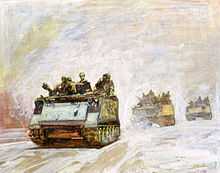Armoured cavalry

Armoured cavalry (or U.S. armored) began to replace horse cavalry as the reconnaissance arm in most armies after the First World War, although many armies continued to maintain horse cavalry through the end of the Second World War.
It differed from regular armour units in that the main AFVs were armoured cars or scout cars, with some light or medium tanks; motorcycle troops or infantry in trucks or half-tracks rounded out the unit.
Historical background
During ancient times and the Middle Ages in Europe, armoured cavalry referred to any horse-mounted troops that used chain mail or plate armour for protection, and often added this to their mount's furniture.
Between the late 17th and mid-19th centuries, armoured cavalry referred to those cavalry regiments that retained the cuirass, and were commonly known as cuirassiers. Later they were sometimes called heavy cavalry which referred to their large horses and not the weight of the cuirass.
After the First World War cavalry units were mostly converted from horses to either armoured cars or tanks and became known as either mechanized cavalry fulfilling a reconnaissance role, or armoured cavalry serving in the offensive role that seeks to break through the enemy defences.
In October 1928, a new era began for the cavalry of the British Army when the 11th Hussars became the first regular cavalry regiment to "mechanize", to change from a horsed cavalry role to a mechanized one, re-equipping with armoured cars previously used by the Royal Tank Corps. Other regiments followed suit; in April 1939, the Royal Armoured Corps was formed to encompass the eighteen mechanized cavalry regiments of the line alongside the eight battalions of the Royal Tank Regiment, but did not include the Household Cavalry. The remaining two regular cavalry regiments were based in Palestine, and following the outbreak of war retained their horses until 1940 (the Royal Dragoon Guards) and 1941 (the Royal Scots Greys). Following mechanization, the few remaining distinctions of unit type became meaningless; cavalry regiments moved between the heavy and light armoured roles regardless of their names.
Vietnam: U.S. armoured cavalry
U.S. Army armoured cavalry has the mission of reconnaissance and security. Unlike armoured and infantry units, U.S. Cavalry is organized in Regiments, Squadrons, and Troops which are equivalent to Brigades, Battalions, and Companies respectively. A regiment of armoured cavalry, such as the 11th Armored Cavalry Regiment (the Black Horse Regiment) in Vietnam, consisted of three full squadrons of armoured cavalry. The squadron normally consisted of a headquarters troop, three cavalry troops, a tank company, a 155-mm self-propelled howitzer battery, and an aviation troop. The three ground troops were a mixture of M48 Patton tanks and M113 ACAVs (Armored Cavalry Assault Vehicles). The aviation troop of the squadron was equipped with helicopters, consisting of UH-1 transports, OH-6 Cayuse scouts, OH-58 Kiowa scout/gunships, and AH-1 Cobra gunships.
Armoured cavalry regiments operated in country for the Corps/Theater Commander, while the squadrons operated as the eyes and ears for the US Army Division Commanders. An Army brigade would only be authorized a cavalry troop, and not a whole cavalry squadron.
According to Army doctrine, the cavalry would find the enemy, and hold the enemy in place; if this was the mission, until the heavy forces were brought up to deal with the located enemy. This process was known as the battle hand-off. The cavalry found them, now the heavies can deal with them; at which point the cavalry is free to disengage and continue with other missions. Security missions could be rear guard, flank guard, or advance guard; the same functions as performed by infantrymen, only with tanks and ACAVs. With the infantry, the advance guard would be called the point man.
During the Vietnam War, it was the mission of armour (tanks) to close with the enemy with firepower, manoeuvre, and shock action to destroy him. With the US Infantry, the mission was the same, minus the shock power. Artillery's mission was to add firepower to the equation. The US Armored Cavalry's mission was to find the enemy and/or provide security for the Army, while having the means to destroy the enemy if becoming decisively engaged. In Vietnam, the US Army deployed 7 Armored Cavalry Squadrons, 1 Armored Cavalry Regiment (containing 3 squadrons), and 2 Armored Cavalry Troops:
1/1st Armored Cav, 2/1st Armored Cav, 1/4th Armored Cav, 3/4th Armored Cav, 3/5th Armored Cav, 1/10th Armored Cav, 11th ACR (11th Armored Cavalry Regiment/Black Horse-3 squadrons), 4/12th Armored Cav (Troop "A" only), 1/17th Armored Cav (Troop "B" only), and the 2/17th Armored Cav, Company D 16th Armor 173 Airborne Brigade.[1]
From about January 1969 until the last mounted unit re-deployed from Vietnam in 1972 (air units remained in country) most armoured cavalry units (except the 11th ACR's tank companies) were equipped with the M551 Sheridan armored airborne reconnaissance assault vehicle (today, known to historians as a light tank).
Armoured cavalry units can use hunter-killer teams. Scout vehicles and tanks can operate in concert, suited respectively as "hunters" and "killers". For instance, in U.S. land forces, the cavalry scouts of a team (often mounted in M3 Bradley Cavalry Fighting Vehicles) go in search of enemy positions, and flush the enemy into a designated kill zone where the armored units can inflict more damage on the enemy than the "hunters" alone could hope to.
See also
Current British cavalry regiments in armoured role
- The Royal Scots Dragoon Guards (Carabiniers and Greys)
- The Royal Dragoon Guards
- The Queen's Royal Hussars (The Queen's Own and Royal Irish)
- The King's Royal Hussars
- 2nd Royal Tank Regiment
See also
- List of US Army armored cavalry regiments
- Air cavalry
References
- Starry, Donn A., General. "Mounted Combat In Vietnam." Vietnam Studies; Department of the Army. First printed 1978-CMH Pub 90-17.
- ↑ Starry